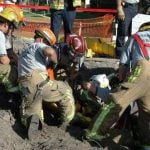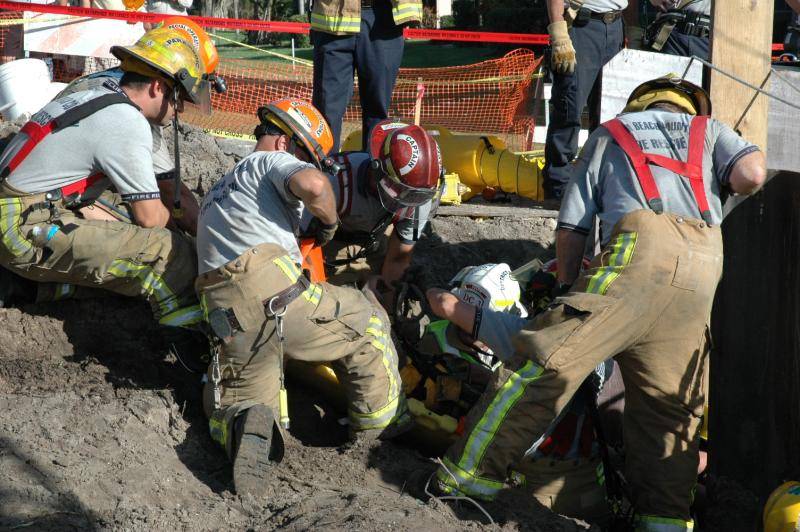Accidents at Work

According to the U.S. Bureau of Labor Statistics, 4,405 people were killed on the job in 2013 and about 1.1 million people suffered injuries on the job that required them to take time off from work. Commercial and home construction workers, factory workers, repairmen and other laborers are much more prone to serious and catastrophic injuries because of their high-risk jobs. Bricklayers and welders, for example, are often required to work on scaffolding, which exposes them to the risk of falling. The same dangers apply to laborers such as painters, electricians and cleaning crews.
In many instances the losses that stem from an injury to a worker affect not just the victim but also his or her family. Work accident injuries place tremendous physical, financial and emotional burdens on both, the injured victims as well as their families. It would be in the best interest of any worker or laborer who has been injured in a New York City workplace accident or a family that has lost a loved one in a work-related accident to contact an experienced personal injury attorney who has successfully handled similar cases.
Workers at Risk of Serious Injury
Those working in any business or industry are susceptible to suffering injuries. However, there are many who work in high-risk areas in which there is a greater chance of suffering a serious or disabling injury on the job. For example, statistics show that those working in the construction industry are at more risk of suffering serious injuries or even death on the job. Recent studies have also shown that in New York City, workers from immigrant populations – especially Latinos – face a much higher risk of suffering injuries in construction accidents.
The study by the Center for Popular Democracy, based on OSHA’s data, shows that 74 percent of fatal falls suffered by construction workers in New York City involved Latino workers. In Queens and Brooklyn, the disparity is even more significant as 88 percent and 87 percent of the fatal falls that occurred in those boroughs involved Latinos or other immigrant workers.
Here are categories of workers who are particularly at risk for serious injury or death on the job:
Ironworkers and Steelworkers: According to the U.S. Department of Labor, the percentage of injuries to ironworkers is among the highest of all career fields. Ironworkers and steelworkers fabricate metal products as well as erect, assemble and install large and heavy building materials. They must be agile to balance and climb especially when working with large structures such as bridges and skyscrapers. It is imperative that ironworkers and steelworkers are provided with safety equipment such as safety belts and nets as well as properly installed scaffolding.
Window washers: High-rise window washers have a dangerous job. They use tools such as a squeegee and commercial window washing chemicals to keep windows clean. The higher elevations involved while on the job means that window washers must have proper safety equipment such as harnesses to ensure fall safety.
Painters: A number of residential and commercial construction sites in New York City utilize painters. These workers are often required to work from heights. Fall safety equipment is a must for painters. In addition, they may need extra protection to guard against breathing in toxic chemicals or substances.
Carpenters: Working mostly with power tools and sharp-edged tools places these workers in continual danger. Carpenters may also be required to work at heights. They are at risk of suffering serious injuries on the job including, but not limited to, loss of limbs, ladder or scaffold falls, neck and back injuries and knee and shoulder injuries.
Electricians: Electrical shock can result in major burns, permanent scarring, damage to internal organs and other catastrophic injuries. Even relatively minor electrical exposure can cause injury or harm to electricians. The most common cause of electrocution is downed power lines or live wires.
Sheet Rock Workers: These are workers who apply plasterboard or other wallboard to ceilings or interior walls of buildings. They may also need to install materials such as acoustical tiles, stops or sheets of shock-absorbing materials to walls and ceilings of buildings to reduce or reflect sound. These workers face significant risks including building collapse.
Bricklayers: These workers build and repair walls inside and outside properties and work on other types of brickwork such as tunnel walls. The job of a bricklayer is to construct the first shell of the building. Bricklayers often work with power tools and face significant risks such as amputations and crushing injuries from building collapses. Since they do work from heights, they also need fall protection devices.
Third Party Compensation for Work Injuries
If you have been injured in the workplace, workers’ compensation is not the only source of compensation. While a victim who has been injured on the job may be entitled to workers’ compensation benefits from his or her employer, there are many situations where the injured party may be able to file an injury claim for damages caused by the injuries. In our experience, we have seen in numerous cases that workers’ compensation benefits in New York are simply not enough to cover the losses where a worker has been catastrophically injured or disabled, or to provide for the family of a worker who has been killed on the job.
Workers’ compensation does not provide punitive damages to punish employers for poor safety controls or egregious safety violations that caused the trauma. The following are additional avenues for workers to seek compensation, often from a third party (a party other than the employer):
Manufacturers of defective products: When a worker is injured by a faulty product such as a defective piece of machinery that malfunctions or defective scaffolding that collapses, the manufacturer of the defective product can be held responsible for the injury. In such situations, the product manufacturers must compensate workers for damages such as medical bills, lost wages and benefits, hospitalization, permanent injury, disability, past and future pain and suffering, etc. Workers may also seek punitive damages in such cases, for example, when a manufacturer knew about its unsafe products, but continued to sell them.
Toxic exposure: A number of worksites use toxic and hazardous chemicals that can cause severe injuries and illnesses. Examples of such substances include asbestos, benzene, lead, silica, etc. There are mainly two types of injuries that result from toxic exposure. Acute injuries are apparent injuries such as chemical burns, poisoning etc. that is symptomatic and must be treated right away. Latent injuries are those that are not apparent right away. Cancer is an example of latent injuries. It takes years or, sometimes, even decades to surface. Workers may be able to file a lawsuit against the manufacturer of the toxic substance or manufacturers of the safety equipment that proved ineffective in the handling of the toxic substance.
Third party negligence: Often, workers are injured because of a third party’s negligence or even wrongdoing. There are a number of entities that come together at a worksite such as a construction project. Some of the parties whose negligence can cause a traumatic accident include:
- A project manager, engineer or architect supervising the project.
- A scaffolding company that fails to install properly.
- The driver of a vehicle that hits and injures the worker.
- Vendors or contractors who are a part of the project.
- A firm that is responsible for equipment maintenance.
- Property owner or building owner.
- General contractors or sub-contractors involved in the project.
Damages in Worksite Accidents
Injured workers may seek compensation for the following damages after a workplace accident:
- All medical expenses
- Lost wages and benefits
- Hospitalization
- Rehabilitative treatment
- Permanent injuries
- Disabilities
- Loss of livelihood
- Loss of consortium
- Past and future pain and suffering etc.
Can You Sue Your Employer?
Sometimes, your employer’s actions (or the lack of it) may allow you to file a lawsuit. If your employer’s conduct is egregious or intentional, you may be able to file an injury lawsuit against your employer. Employees may also be able to sue their employers outside of the workers’ compensation system if the employer’s actions are grossly negligent or reckless, and resulted in injuries for the employees.
For example, if an employer wants a worker to operate in a trench that does not have the legally mandated protections such as proper equipment to shore up the sides and stable walls, then, the worker can sue the employer if the trench collapses and injures him. Often, construction companies, contractors or manufacturing plants that fail to follow federal safety standards are cited and fined by the U.S. Occupational Safety and Health Administration (OSHA). Investigators with OSHA usually investigate major worksite accidents.
If You Have Been Injured
If you are a worker who has been injured in a worksite accident, it is important that you report the incident to your supervisor as soon as possible. Keep a copy of the incident report that you submit to your employer. Go to the emergency room and a doctor if you have been injured – even if you believe that your injuries are minor. File for workers’ compensation benefits.
Make sure you go to an employer-specified doctor. Your employer may require you to go to a certain doctor or physician. Keep a comprehensive record of all expenses you incurred as a result of your injury. Maintain a journal with specific details about your recovery process including the pain you experience and a record of the activities you are now unable to perform as a result of the injuries. Contact an experienced New York personal injury lawyer who has successfully handled workers’ compensation cases and third-party claims.
Verdicts and Settlements
We have helped our clients secure favorable verdicts and settlements in workplace accident cases. Here are a few examples.
$3,375,576: A construction worker who was injured on the job. This was one of the highest construction case settlements in New York in the year 2010.
$2,433,500: A worker who fell through planks on a construction site. The man claimed that the construction company and the building owner were negligent and the fall should have been avoided.
$2,350,000: A worker who suffered toe amputation because debris had been left in a pathway where he walked as he worked at a construction site.
$1,700,000: A worker who fell due to faulty scaffolding at a construction site and fractured his hip, back and arm. Our client claimed he was permanently disabled due to this accident and could not return to construction work. The case was settled during trial for $1,700,000 and we were able to save the injured worker the $175,000 he owed to the workers’ compensation insurance company.
$1,250,000: A construction worker who was injured after falling off a scaffold. Although the maximum insurance policy limit was $1,000,000, we were able to get $1,250,000 for this client through our efforts.
$900,000: The family of a man who fell off a scaffold and was fatally injured.
Contacting an Experienced Lawyer
If you or a loved one has been injured in a worksite accident, the experienced New York personal injury attorneys at the Law Offices of Kenneth A. Wilhelm can help you better understand your legal rights and options. Please contact us TOLL FREE 24 hours a day, 7 days a week at 1-800-WORK-4-YOU (1-800-967-5496). WE CAN EVEN COME TO YOU. There is no attorneys’ fee unless we recover money for you. We can also help with personal injury cases in New Jersey, Connecticut, Pennsylvania, or Florida. If you have been seriously injured in any of the 50 U.S. states, please call us and we will try to help you with your case.
Other TOLL FREE phone numbers for us are:
1-800-RADIO-LAW, 1-888-WYPADEK, OR 1-800-LAS-LEYES
Please visit us at: www.WORK4YOULAW.com










